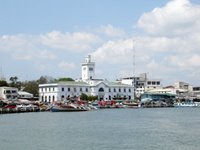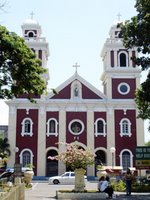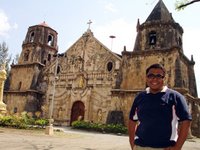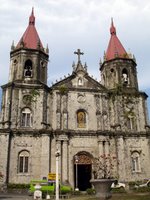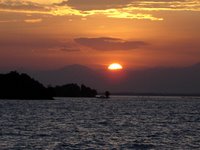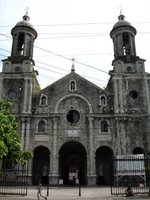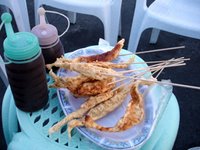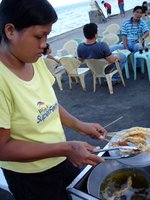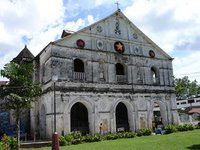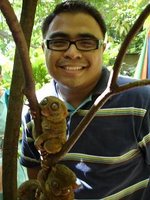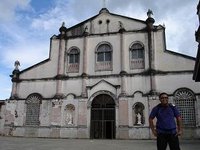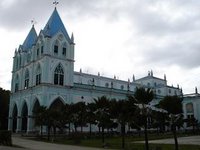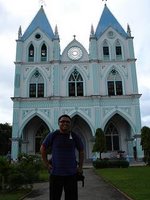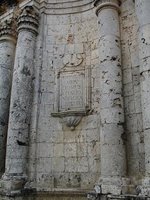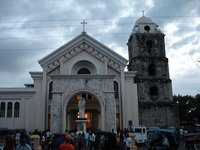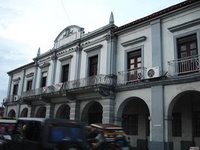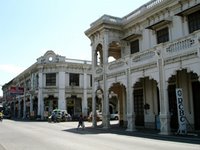 Silay City, this genteel and elegant town north of Bacolod was once an important commercial hub thanks to the introduction of the horno economico (sugar mill) by Yves Gaston, a Frenchman turned Silaynon. What Bacolor was to Pampanga (Athens of Pampanga), Silay was to Negros (Paris of Negros) since it was the cultural and intellectual hub of the province.
Silay City, this genteel and elegant town north of Bacolod was once an important commercial hub thanks to the introduction of the horno economico (sugar mill) by Yves Gaston, a Frenchman turned Silaynon. What Bacolor was to Pampanga (Athens of Pampanga), Silay was to Negros (Paris of Negros) since it was the cultural and intellectual hub of the province. I began my day by taking a walk to the Provincial Capitol of Negros Occidental which was just a few minutes from our house. This magnificent structure was designed by none other than renowned architect Juan Arellano and was declared a national historical landmark in 2004. Indeed, it is one of the most monumental provincial capitols ever constructed in our country. Sigh! Reminds me again of the current state of Philippine architecture. Our government engineers don't know the meaning of aesthetics and build structures that simply have four walls and a ceiling! The less materials you use, the more goes into the pockets... Oh well!
I began my day by taking a walk to the Provincial Capitol of Negros Occidental which was just a few minutes from our house. This magnificent structure was designed by none other than renowned architect Juan Arellano and was declared a national historical landmark in 2004. Indeed, it is one of the most monumental provincial capitols ever constructed in our country. Sigh! Reminds me again of the current state of Philippine architecture. Our government engineers don't know the meaning of aesthetics and build structures that simply have four walls and a ceiling! The less materials you use, the more goes into the pockets... Oh well! From the capitol, I took a jeep that would drop me off further down the road where jeeps and buses to Talisay, Silay and other northern towns and cities are located. The trip was about thirty minutes and costed me only PHP10. Now that gas is so expensive, prices like these make you want to commute even more. The only thing I didn't like about it was the heat and the drivers stopping too long to attract passengers. In fact, it became so annoying when they'd even back-up to try to lure passengers!
From the capitol, I took a jeep that would drop me off further down the road where jeeps and buses to Talisay, Silay and other northern towns and cities are located. The trip was about thirty minutes and costed me only PHP10. Now that gas is so expensive, prices like these make you want to commute even more. The only thing I didn't like about it was the heat and the drivers stopping too long to attract passengers. In fact, it became so annoying when they'd even back-up to try to lure passengers!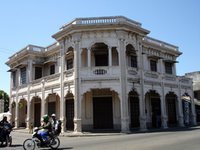 As soon as you exited the city limits of Bacolod, you saw vast fields of sugar cane on either side of the road in Talisay City and then Silay. Sugar really made Negros a very prosperous island which explains why there are so many cities in both provinces, one highly-urbanized city and 12 component cities in Negros Occidental and 5 component cities in Negros Oriental.
As soon as you exited the city limits of Bacolod, you saw vast fields of sugar cane on either side of the road in Talisay City and then Silay. Sugar really made Negros a very prosperous island which explains why there are so many cities in both provinces, one highly-urbanized city and 12 component cities in Negros Occidental and 5 component cities in Negros Oriental.I knew we were in Silay when the surroundings changed. If not for the jeepneys and other vehicles, you would think you are in another country.
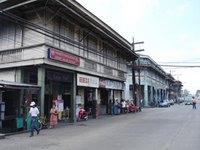 I took a walk around the town and checked out the different houses. At the center of town was the San Diego Pro-Cathedral and its clock tower. Along the main street were old homes and shophouses. Wow! They don't make buildings and houses like this anymore. The designs were so intricate and grand!
I took a walk around the town and checked out the different houses. At the center of town was the San Diego Pro-Cathedral and its clock tower. Along the main street were old homes and shophouses. Wow! They don't make buildings and houses like this anymore. The designs were so intricate and grand!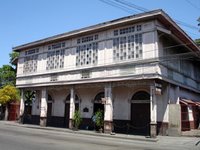 Actually, the City of Silay has the most number of NHI-declared heritage houses, twenty-four if I'm not mistaken. A distant second to Silay is San Fernando, Pampanga with four. The numbers are not conclusive though. It simply shows which cities are most interested in heritage since San Fernando, I would have to admit, will not stand a chance if compared to towns like Sariaya in Quezon, San Juan in Batangas and San Miguel de Mayumu in Bulacan. At the same time, the numbers show how slow it takes the NHI to declare structures! With the speed these structures are demolished, the NHI must match that speed if it is to protect what remains of our national heritage after most of it was flattened during the liberation.
Actually, the City of Silay has the most number of NHI-declared heritage houses, twenty-four if I'm not mistaken. A distant second to Silay is San Fernando, Pampanga with four. The numbers are not conclusive though. It simply shows which cities are most interested in heritage since San Fernando, I would have to admit, will not stand a chance if compared to towns like Sariaya in Quezon, San Juan in Batangas and San Miguel de Mayumu in Bulacan. At the same time, the numbers show how slow it takes the NHI to declare structures! With the speed these structures are demolished, the NHI must match that speed if it is to protect what remains of our national heritage after most of it was flattened during the liberation. A visit to Silay would not be complete without passing by Balay Negrense, the Gaston Ancestral House which has been converted into a museum. There is another house open to the public, the Jalandoni Ancestral House, but I didn't have much time since I had to go back to Bacolod to prepare for my late afternoon flight.
A visit to Silay would not be complete without passing by Balay Negrense, the Gaston Ancestral House which has been converted into a museum. There is another house open to the public, the Jalandoni Ancestral House, but I didn't have much time since I had to go back to Bacolod to prepare for my late afternoon flight.Back in Bacolod, I finished some concerns with the house and I was off. On the way to the airport, I passed by the Bacolod Memorial Park to visit the graves of my grandparents for the very first time. Sigh!
The PAL flight was one-hour delayed. Just great, I shouldn't have rushed. Hehe! And now, I'm back in Manila. I've done a lot of travelling in the Visayas, it's time for a break. I got free AirAsia tickets to Cambodia during their anniversary promo last December (of course we still pay for taxes and insurance so it amounted to about PHP4500). So for next two weeks I'll be blogging about my backpack trip to Cambodia and Laos. But Mindanao here I come coz I was able to purchse the PHP1 tickets of Cebu Pacific. I'm off to Zamboanga and Davao later this year!

